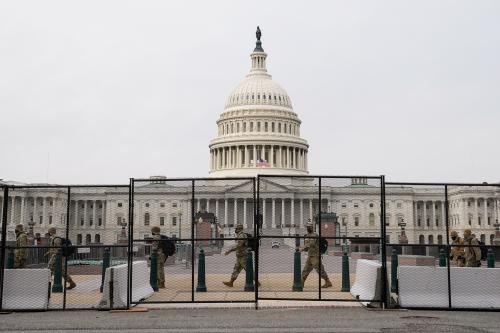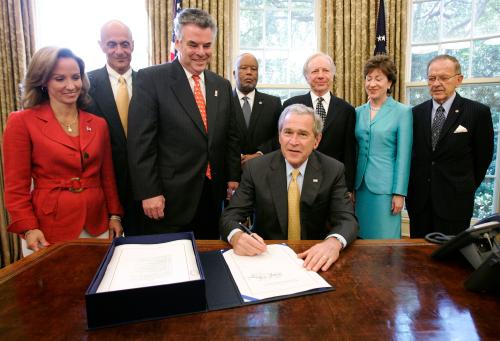The following is part of the Series on Counterterrorism and American Statutory Law, a joint project of the Brookings Institution, the Georgetown University Law Center, and the Hoover Institution
Introduction
The Supreme Court’s recent decision in Boumediene v. Bush, holding that prisoners at Guantanamo have a constitutional right to habeas corpus review of their detention by federal courts, has injected new fuel into the debate about whether Congress should enact administrative detention legislation. To its advocates, administrative detention—or detention by the Executive branch without criminal prosecution in the courts—is a potentially important counter-terrorism tool. New legislation, they argue, would more effectively and legitimately regulate detention practices of suspected terrorists that to date the Bush Administration has conducted under an expansive notion of unilateral war powers. But critics warn that administrative detention is a dangerous tool as well, not just because it threatens liberty and entails expanded powers of the State, but also because its overuse or injudicious use may be counter-productive in combating violent extremism. Rather than institutionalizing and regulating it through legislation, opponents and skeptics of administrative detention generally argue that, especially outside combat zones, detention of suspected terrorists should be handled through criminal prosecution, with its tight rules limiting state powers and safeguarding individual suspects’ liberties. According to a recent statement by the Constitution Project, administrative detention proposals “neglect basic and fundamental principles of American constitutional law, and they assume incorrectly that the traditional processes have proven ineffective.”
My purpose in these pages is not to convince the reader that a new administrative detention regime is necessary, nor do I mean to offer a specific legislative roadmap towards one. I have argued elsewhere for “a durable, long-term framework for handling detainees—one that lets [the United States government] hold the most dangerous individuals [it captures] and collect intelligence from them (including through lawful interrogation), but also (unlike Guantanamo Bay) has rules and procedures that are politically, legally and diplomatically sustainable.” Other papers in this series argue for various approaches to preventive detention. In this paper, rather, I aim to examine what seem at first like simple questions underlying the discussion of administrative detention and the possible need for new laws: in combating terrorism, why administratively detain, and detain whom?
The answers to these questions seem obvious at first. We should detain individuals to prevent terrorism and, to that end, we should detain terrorists. And with those basic ideas apparently settled, the administrative detention debate tends to jump quickly to the question of how to detain: What procedural protections should we afford suspects? What rights should we grant them to challenge evidence proffered against them? What kinds of officials will adjudicate cases? Those advocating new administrative detention laws generally call for robust judicial review of what have largely been executive-only detention decisions since the early days of the Bush Administration’s Global War on Terror—perhaps by a new “national security court” charged with overseeing a process that includes adversarial process and meaningful assistance of lawyers. And at that point, the discussion moves just as quickly to questions of institutional design, and such procedural details as evidentiary rules, the type of judges who will hear these cases, detainee access to counsel, and counsel’s own access to classified information. Administration detention critics, too, focus heavily on the procedural dynamics of administrative detention proposals: how would detention decision-making and, for that matter, the standards and rules governing those decisions, deviate from normal criminal justice rules?
The Supreme Court similarly focused almost exclusively on procedural mechanisms in its Boumediene ruling. While mandating that Guantanamo detainees receive access to U.S. federal courts empowered to correct errors after “meaningful review of both the cause for detention and the Executive’s power to detain,” the Court made clear that it was “not address[ing] the content of the law that governs petitioners’ detention.”
The questions everyone seems keen to skip over, however, are not nearly as obvious as their omission suggests. In this paper, I therefore take a step back from the issues surrounding how to make and review detention decisions and engage the antecedent questions of why detain and, therefore, whom to detain. In doing so, I mean to advance two overarching arguments that should guide the discussion of whether the United States needs administrative detention laws and, if so, of what type. First, any discussion of administrative detention should begin with a clear understanding of the strategic rationale for administrative detention and a sense of how detention fits within a broader counter-terrorism and national security strategy. Our answers to the “why detain?” question will drive our answers to the “whom to detain?” question, and those answers together will significantly affect the matrix of costs and benefits of legal innovation. Second, the way we answer the “why” and “whom” questions will, in turn, significantly determine the procedural architecture of any new administrative detention regime. This paper therefore cautions against jumping too quickly in administrative detention discussions to the issue of procedural design, or the “how” questions.
To whatever extent Congress decides that the United States needs a new administrative detention apparatus, this analysis points in favor of narrowing significantly the strategic flexibility and expansive operational latitude the Bush Administration has asserted through its legal interpretations. It recommends that architects of proposed administrative detention schemes focus on the strategic objectives of either immediate-term disruption of terrorist plots or long-term incapacitation of suspected terrorists (and, as this analysis shows, it may not be as easy as it seems to design a system that does both effectively). Further, it advises against broad substantive criteria like “enemy combatancy” or “membership” in favor of a more narrow and specific inquiry of an individual’s supposed dangerousness, perhaps supplemented with additional substantive requirement. With those strategic aims and substantive detention criteria in mind, this paper comes back to the procedural debate and concludes with a discussion of effective, corresponding procedural design.


